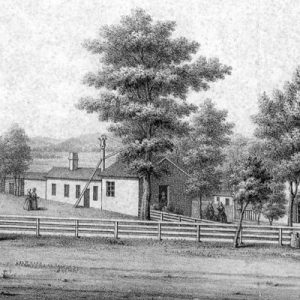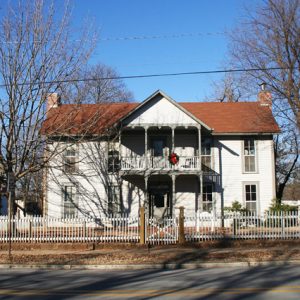calsfoundation@cals.org
Sarah Bird Northrup Ridge (1804–1856)
Sarah Northrup Ridge, who married Cherokee leader John Ridge, was part of the forced removal of the Cherokee, culminating in the notorious Trail of Tears. Settling in Fayetteville (Washington County) after the murder of her husband, she was instrumental in establishing the town’s reputation as an educational center.
Sarah Bird Northrup was born on December 7, 1804, in Cornwall, Connecticut, to Lydia Camp Northrup and John Prout Northrup, steward of the American Board of Commissioners for Foreign Missions School in Cornwall, which accepted Cherokee students.
The Cherokee, primarily from Georgia, were assimilating in many cases into the white population. By the early 1800s, the Cherokee adopted Christianity, were residing in the same kinds of homes as the whites, raised the same crops, and lived the same lifestyle. However, when gold was discovered in Georgia in 1828, there was increasing pressure from the state of Georgia and the U.S. government to remove the Cherokee to lands west of the Mississippi River.
Because Cherokee leaders believed that reading and writing English were important skills in conducting themselves among white government officials, they sent Cherokee students to schools such as Cornwall. In 1821, one of the Cherokee students at Cornwall was John Ridge (1802–1839), son of a wealthy Cherokee leader. The eighteen-year-old Ridge had health problems that were aggravated by the cold New England winters. When his condition worsened, he was moved from the dormitory to a room in the Northrup home. There, John Ridge and fourteen-year-old Sarah Northrup fell in love.
Northrup’s disapproving family sent her away to live with her grandparents. John Ridge’s parents also disapproved, insisting he marry a Cherokee woman. Despite opposition from both families, John Ridge and Sarah Bird Northrup were married in Connecticut on January 27, 1824. It set off a firestorm. For couples who undertook such marriages, editorials suggested horsewhipping or worse. John and Sarah Ridge quickly left Connecticut for the Cherokee capital of New Echota, Georgia. They settled on a plantation estate of more than 400 acres and had seven children.
John Ridge became an attorney and was a leading member of the Cherokee National Council as the desire of white Americans for Cherokee lands intensified when word spread about gold in Georgia. In 1838, the U.S. Army began removing the Cherokee to Indian Territory (present-day Oklahoma). The Cherokee became divided into two factions. The Ridge Party, led by John Ridge’s family, felt that removal was inevitable. The Ross Party, under the leadership of John Ross, swore to fight it.
John Ridge was among those who signed the removal treaty, feeling that the move west might keep the Cherokee people from being annihilated by white soldiers. Followers of the Ridge Party left their Cherokee homeland for Indian Territory on would come to be called the Trail of Tears. John and Sarah Ridge, with their children, settled at a place called Honey Creek in Indian Territory, just west of the Arkansas border.
John Ridge was assassinated in 1839 for his part in negotiating the loss of Cherokee lands. Sarah Ridge took her children and fled to Fayetteville. With her, she brought educator Sophia Sawyer (1792–1854), who had taught the Ridge family and other Cherokee children both in Georgia and at Honey Creek.
In 1839, Sophia Sawyer founded the Fayetteville Female Seminary, where prominent white and Cherokee children were students. Its status was a significant factor in Fayetteville’s reputation as a center of superior education.
Sarah Ridge helped at Sawyer’s school, which was built near Ridge’s home. The Sarah Bird Northrup Ridge House is the oldest house still standing in Fayetteville, dating back to 1836. According to the Washington County Historical Society, which preserved the home, its original pine flooring and fieldstone fireplaces survived the Civil War and have endured into the twenty-first century.
Because John Ridge died without a will, Sarah Ridge was compelled to travel from Fayetteville to Indian Territory to sort out his financial affairs on behalf of their children. She reportedly lived in Osage Prairie near Centerton (Benton County) for a time, beginning in 1842; she and her children are listed on the 1850 federal census as living in Benton County. She returned permanently to Fayetteville by 1854. That same year, her son, John Rollin Ridge, published a book that later saw him acclaimed as the first Native American novelist.
On March 31, 1856, Sarah Northrup Ridge died of pneumonia at age fifty-two. She is buried at Fayetteville’s Mount Comfort Cemetery.
The Sarah Bird Northrup Ridge House was listed on the National Register of Historic Places in 1972 and is an unofficial Trail of Tears landmark recognizing the forced removal of the Cherokee.
For additional information:
Poole, Arlen D. “Life of Sarah Bird Northrup Ridge.” Flashback 57 (Summer 2007): 49–66.
Washington County Historical Society. http://www.washcohistoricalsociety.org (accessed May 11, 2017).
Nancy Hendricks
Garland County Historical Society
 Louisiana Purchase through Early Statehood, 1803 through 1860
Louisiana Purchase through Early Statehood, 1803 through 1860 Fayetteville Female Seminary
Fayetteville Female Seminary  Sarah Bird Northrup Ridge
Sarah Bird Northrup Ridge  Sarah Bird Northrup Ridge House
Sarah Bird Northrup Ridge House 




Comments
No comments on this entry yet.